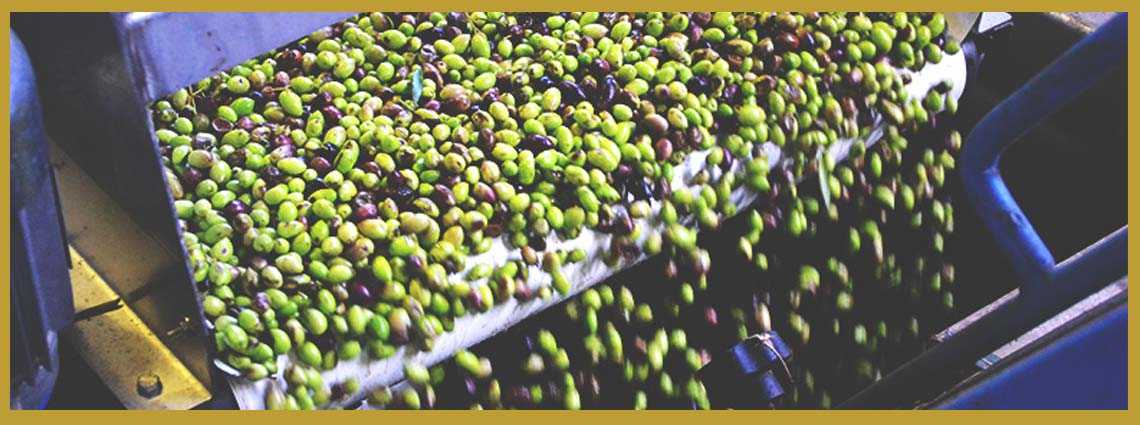- Tips and tricks
- 0 likes
- 113497 views

We all know that olive oil is one of the treasures of our gastronomic heritage, and a reference in the Mediterranean Diet, but have you ever wondered how olive oil is made?
In recent years, the olive oil extraction industry has experienced a technological evolution that has allowed it to adapt to new times, with new techniques and machinery.

The new regulations in the oil sector have also forced olive oil producers to modernize, but the basic principles in the olive oil extraction have not changed.
At present, the olive oil production is still an arduous task that is mechanized but still has its handcrafted part.
Making olive oil
The quality of olive oil derives from being a fruit juice that can be consumed directly, unlike any other type of vegetable oil. Being a natural product, a series of basic factors must be taken into account to keep the olive oil quality:
- Obtaining quality is a chain that begins in the olive tree and ends when the packaged oil reaches the consumer, so all those involved (farmers, oil mills, packers, distributors) must ensure that they comply with their purpose so as not to break any link that affects a loss of quality.
- Although it is impossible that all the oil obtained is of excellent quality, the priority objective will be to obtain the maximum amount of olive oil with good characteristics, separating it from those of medium or lower quality. This results in different types of olive oil.
Olive oil manufacturing process
Traditionally, the process of making olive oil is divided into different stages that end with olive oil packaging. The correct optimization of each stage will determine the quality and characteristics of olive oil.
Continue reading and discover how olive oil is made, from the harvest to the final packaging, through each of the stages of the process carried out in an olive oil plant.
Step 1: Process of olive harvesting
The olive is the first link in the olive oil production process and also define the amount of oil produced.
It can be carried out in different ways, currently in Spain the systems that are most used are the vareo and the mechanical vibration of branches and trunks.
- Vareo: wooden rods are used to hit the fruit, which falls on the shawls prepared by the collector, although there are fewer and fewer olive oil producers who use this system, mainly because in the process the fruit can be damaged and therefore lose quality olive oil.
- Mechanical vibration: specific olive oil machine is used, either with arm vibrators that attach to the branches, or with vibrating tractors that move the olive tree from the trunk.
It is essential to obtain good quality olive oils that the flight olives are always separated from the soil by the provision of shawls under the olive tree.
During the harvest, the olives are separated according to their variety and quality and are transported to the olive oil mill in suitable containers to avoid spoilage or in bulk in trailers.
It is essential that this process be carried out in a minimum period of 24 hours since they were collected, which is used to name a type of olive oils known as early harvest oil.
At this point it is important to remember our article on early harvest olive oils, since the time chosen for the harvest will also be a determining factor in the quality, quantity and final price of the oil.

Step 2: Grind the olives so they are clean
Once in the mill, the branches and leaves of the olives are removed, usually by blowing air. Next, it is recommended to wash the olives with water before being weighed and transported to the storage hoppers.
Finally, the fruit is ground or crushed (olive grinding). Must be ground the same day of collection (within 24 hours) to prevent fermentation and oxidation.
Step 3: Process of crushing the olives
To carry out this process formerly used millstones, currently this process can be done with a hammer crusher, the goal is to break down plant tissues and release oil to obtain a homogeneous paste.
Subsequently, this paste goes to the shake phase, which must be carried out for at least one hour at an ambient temperature between 24 and 27 degrees so that the oil separates from the rest (pulp, bone, skin and water).
It is very important to keep this temperature constant to guarantee a cold extraction process of the oil.
Step 4: Press the olive to extract the oil juice
In order to extract the juice from the olives, a strong mechanical pressure must be exerted on the already whipped pasta. Traditionally for centuries, olive oil extract it has been done by pressing the paste
In this system, first the separation of the solid phase is made and then the separation of the liquid phases is carried out: oil and alpechin.
In recent years technological advances have been made to optimize this process, with this has been achieved to improve efficiency and reduce the amount of waste produced by olive oil mills, measures aimed at a more sustainable production and respectful of the environment.
For this reason, in the mid-70s, the centrifugation system was introduced in Spain. At present there are approximately 1,750 olive oil producers in Spain, of which about 0.5% have the pressing system and the rest uses centrifugation.
In the olive oil centrifuge system there is always a separation of three phases in the decánter: solid, liquid oil, and liquid alpechin. However, while in the centrifugation of three phases the different phases are separated, and is what has been used in recent years, new developments in the sector have allowed the development of two-phase centrifugation.
In this two-phase system, also called ecological, the solid and liquid alpechin phases come together, and separated from the liquid oil. It has been shown that it is the most efficient system and that is why it is the most used, in Spain, 98% of olive oil producers work with two-phase centrifugation systems and only 2% use three-phase systems.
Step 5: Decanting olive oil
Decanting is a natural process by which, thanks to the density difference of olive oil, the oil, water and solids still present are separated. Currently the most widely used system in Spain is the two-phase centrifugation.

The resulting oil is usually accompanied by a small percentage of solid and liquid impurities, so it has to be subjected to a final cleaning or purification process, this operation is performed using vertical centrifuges.
Step 6: Quality control of olive oil
The decanted oil passes to a tanks called “pre-warehouse” where it is stored for 24-48 hours and the rest of the impurities that may remain in the oil are filtered. This is the difference between filtered and unfiltered olive oil. After this process the oil goes to the main tanks.
The olive oil storage has improved markedly in recent years. Although large air deposits continue, there are many olive oil producers that have been modernized, and use large tanks that allow the separation of qualities.
It is at this moment when the qualified personnel must perform a sampling to evaluate the quality and carry out the initial classification of the oil batch. This assessment is usually made based on the content of acidity and the organoleptic characteristics under the criterion of production.
Once the quality of the batch of oil has been quantified, it is transferred to the corresponding container, which has previously been differentiated in order to separate different qualities.
Step 7: Olive oil packaging
At present, the packaging machines work continuously and have variable volume dosing systems, depending on the packaging that is to be used.
The types and formats of the containers vary depending on the category of the oil to be packaged, for the higher categories it is required that they are non-deformable, impermeable to oil and gases, resistant, and that they add value to the contents.
As for the packaging, the most used for virgin and extra virgin olive oil is glass and tin. The rest of categories are usually packed in PET, which offers an excellent quality / price ratio.
How many kilograms of olives do you need to produce a liter of olive oil?
To produce one liter of olive oil, between four and five kilograms of olives are necessary. This indicates that the average yield of oil weight is approximately between 18% and 24% with respect to the weight of the olives processed to obtain it.

Although this is the general rule, reality tells us that this proportion can vary depending on different factors such as the climate, the time of harvest and the variety of the olive.
For example, in early harvest oils this proportion is significantly lower, in this case to produce a liter of olive oil, you need at least eight kilos of early olives.
Differences between artisanal olive oil and industrial olive oil
Artisanal olive oil can be considered that is obtained by pressing the olives. This system, as we explained above, is used less and less, since it has been replaced by centrifugation, which manages to extract the juice of olives faster and in an automated way.
The main advantage of the centrifugation system over the pressing system is that it requires less labor and, above all, that olive oils of lower acidity and therefore of higher quality are produced. So, we can say, that the industrial olive oil is for sure, a better quality olive oil.
Among the disadvantages we can highlight the higher energy consumption and the lower value of the pomace oil produced.
To finish we would like to leave you some brief final conclusions: good quality olive oil will depend on the good state of the fruits, a careful process of preparation, a correct classification of the oil and of an adequate storage and conservation.
If you have any questions or need more information about the preparation of olive oil do not hesitate to contact Olivadelsur, our specialized customer service will always be available to help you.
